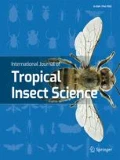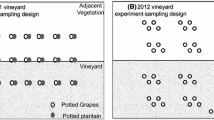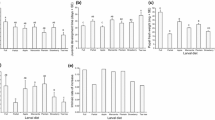Abstract
Surveys were conducted in 1981, 1983 and 1984 across the island of Puerto Rico to determine the effects of patch characteristics of the tropical herbaceous legume, Crotalaria pallida Ait. on the herbivore and its parasitoids. The mean number of flower racemes per plant and mature pods per raceme varied from year to year and appeared to be influenced by rainfall patterns, but were independent of patch size or plant density. Low larval parasitism was also observed during dry seasons. Proportion of plant patches colonized by Etiella zinckenella was smallest during dry seasons. Local extinction of C. pallida patches was found commonly, with a 77.4% extinction rate during a 6-month period. Patch extinction, which was caused mainly by human activity, was independent of patch size.
Pods of C. pallida within patches were inspected for lima bean pod borer, E. zinckenella (Lepidoptera: Phycitidae) injury. The number of pods bored per mature raceme, and the per cent of bored pods were positively correlated with the number of host-plants per patch and the (surface) area of the patch. No correlation was found between per cent parasitism and pod borer larval density. However, per cent parasitism was influenced directly by C. pallida plant density and patch surface area. Given the transient nature of C. pallida patches and the changes that occur over a season, these positive responses of parasitoids to plant density and patch surface area are important components for their successful exploitation of larval hosts.
Résumé
Des enquêtes menées en 1981, 1983 et 1984 sur toute l’étendue de l’Ile de Puerto Rico visant à déterminer les caractéristiques des parcelles de la légumineuse Crotalaria pallida Ait et les effets qu’elle pourrait avoir sur les ravageursde cette plante et leurs parasitoïdes. Le nombre moyen de grappes et celui des gousses parvenant à maturité par plant varie suivant les années et semble dépendre des variations pluviométriques, alors que les dimensions des parcelles et la densité des plants par parcelle ne semblent pas exercer d’effet. Le parasitisme larvaire pendant les saisons sèches est également bas. La proportion de parcelles de plants infestées par Etiella zinckenella était également basse au coins des saisons sèches. Des extinctions de C. pallida dans les parcelles atteignant 77.4% en 6 mois out été en général notées. Ces disparitions dans les parcelles dues aux activités humaines sont indépendantes des dimensions des parcelles. Des enquêtes ont été effectuées sur les dégâts causes par le foreur de gousses du haricot, E. zinckenella (Lepidoptera: Phycitidae). II a été établi une corrélation positive entre le nombre de gousses forées par grappe murie, le pourcentage de gousses forées avec le nombre de plantes hôtes par parcelle de même qu’avec la superficie de la parcelle considérée. Aucune relation n’a été observée entre le pourcentage de parasitisme et la densité larvaire du foreur; cependant une influence directe de la densité deC. pallida et la surface de la parcelle considérée sur le degré de parasitisme est observée. Considérant la nature éphémère des parcelles de distribution de C.pallida et les changements qui surviennent au cours d’une saison, les relations positives observées entre parasitoïdes, densité de plants et la superficie plantée sont des composantes importantes pour une utilisation judicieuse des hôtes de larves.
Similar content being viewed by others
References
Alticri M. A. and Whitcomb W. H. (1978/1979) Manipulations of insect populations through seasonal disturbance of weed communities. Prot. Ecol. 1, 185–202.
Armstrong A.M. (1988) Light trap study of Heliolhis virescens (Fab.) and Etiella zinekenella (Treat.) on pigeon pea Cajanus cajan. J. Agric. Univ. Puerto Rico 72, 557–563.
Bach C. E. (1984) Plant spatial pattern and herbivore population dynamics: Plant factors affecting the movement patterns of a tropical cucurbit specialist. Ecology 65, 175–190.
Barbosa P. and Wagner M. (1989) Introduction to Forest and Shade Tree Entomology. Academic Press, New York, New York.
Beddington J. R., Frce C. A. and Lawton J. H. (1978) Characteristics of successful natural enemies in models of biological control of insect pests. Nature 273, 513–519.
Blau W. S. (1980) The effect of environmental disturbance on a tropical butterfly population. Ecology 61, 1005–1012.
Blau W. S. (1981) Latitudinal variation in the life histories of insects occupying disturbed habitats: A case study. In Insect Life History Patterns (Edited by Denno R. F. and Dingle H.), pp. 75–95. Springer-Verlag, New York.
Comins H. N. and Hassell M. P. (1979) The dynamics of optimally foraging predators and parasitoids. J. Anim. Ecoi. 48, 335–351.
Connell J. H. (1978) Diversity in tropical rain forests and coral reefs. Science 199, 1302–1310.
Connell J. H. and Slayter R. O. (1977) Mechanisms of succession in natural communities and their role in community stability and organization. Amer. Natur. 111, 1119–1144.
Connor E. F. and McCoy E. D. (1979) The statistics and biology of the species-area relationship. Amer. Natur. 13, 791–833.
Cook R. M. and Hubbard S. F. (1977) Adaptive searching strategies in insect parasites. J. Anim. Ecol. 46, 115–125.
Dempster J. P. (1983a) The ecology of Cinnabar moth, Tyria jacobaeae L. (Lepidoptera: Arcliidac). Adv. Ecol. Res. 12, 1–36.
Dempster J. P. (1983b) The natural control of populalionsof bulterflies and moths. Biol. Rev. 58, 461–481.
Dempster J. P. and Pollard E. (1981) Fluctuations in resource availability and insect populations. Oecologia 50, 412-16.
den Boer P. J. (1981) On the survival of populations in a heterogeneous and variable environment. Oecologia 50, 39–53.
Denno R. F. (1983) Tracking host plants in space and time. In Variable Plants and Herbivores in Natural and Managed Systems (Edited by Denno R. F. and McClure M. S.). Academic Press, New York.
Denno R. F., Raupp M. J., Tallamy D. W. and Rcichclderfer C. F. (1980) Migration in heterogeneous environments: Differences in habitat selection between the wing forms of the dimorphic planthopper, Prokelisia marginata (Homoptera: Delphacidac). Ecology 61, 859–867.
Dethicr V. G. (1959) Egg-laying habits of Lepidoptera in relation to available food. Can. Entomol. 91, 554–561.
Egley G. H. (1979) Seed coat impermeability and germination of showy Crotalaria (Crotalaria spectabilis) seeds. Weed Sci. 27, 355–361.
Evans E. S. W. (1983) The influence of neighboring hosts on colouration of prairie milkweeds by a seed-feeding bug. Ecology 64, 648–653.
Faeth S. H. and Simberloff D. (1981) Experimental isolation of oak host plants: Effects on mortality, survivorship, and abundances of leaf-mining insects. Ecology 62, 625–635.
Feeny P. (1976) Plant apparency and chemical defense. Rec. Adv. Biochem. 10, 1–40.
Force D. C. (1974) Ecology of insect host-parasitoid communities. Science 184, 624–632.
Fox L. R. and Morrow P. A. (1982) Specialization: species property or local phenomenon? Science 211, 887–892.
Fowler S. V. (1984) Foliage value, apparency and defense investment in birch seedlings. Oecologia 62, 387–392.
Hall R. W. and Ehler L. E. (1980) Populations ecology of Aphis nerii on Oleander. Environ. Entomol. 9, 338–344.
Hassell M. P. (1982) Patterns of parasitism by insect parasitoids in patchy environments. Ecol. Entomol. 7, 365–377.
Hassell M. P. and South wood T. R. E. (1978) Foraging strategies of inseets. Annu. Rev. Ecol. Syst. 9, 75–98.
Hopper K. R. (1984) The effects of host-finding and colonization rates on abundances of parasites of a gall midge. Ecology 65, 20–27.
Huffaker C. B. (1962) Some concepts on the ecological basis of biological control of weeds. Can. Entomol. 94, 507–514.
Janzen D. H. (1968) Host plants as islands in evolutionary and contemporary time. Amer. Natur. 102, 592–595.
Janzen D. H. (1972) Escape in space by Sterculia apetala seeds from the bug Dysdercus fasciatus in a Costa Rican deciduous forest. Ecology 53, 350–361.
Janzen D. H. (1973a) Host plants as islands. II. Competition in evolutionary and contemporary time. Amer. Natur. 107, 786–790.
Janzen D. H. (1973b) Tropical agroecosystems. Science 182, 1212–1219.
Janzen D. H. (1973c) Sweep samples of tropical foliage insects: Effects of seasons, vegetation types, elevation, time of day, and insularity. Ecology 54, 687–708.
Kareiva P. (1983) Influence of vegetation texture on herbivore population resource concentration and herbivore movement. In Variable Plants and Herbivores in Natural and Managed Systems (Edited by Denno R. F. and McClure M. S.). Academic Press, New York.
Kuris A. M., Blaustein A. R. and Alio J. J. (1980) Hosts as islands. Amer. Natur. 116, 570–586.
Lemen C. (1981) Elm trees and elm leaf beetles: Patterns of herbivory. Oikos 36, 65–67.
Levin S. A. (1976) Population dynamic models in heterogeneous environments. Annu. Rev. Ecol. Syst. 7, 287–310.
Levins R. and Wilson M. (1980) Ecological theory and pest management. Annu. Rev. Entomol. 25, 287–308.
Maguire L. A. (1983) Influence of collard patch size on population densities of lepidoptcran pests (Lepidoptera: Pieridae, Plutellidae). Environ. Entomol. 12, 1415–1419.
May R. M. (1974) Stability and Complexity in Model Ecosystems. Princeton University Press, Princeton, NJ.
McLain D. K. (1981) Numerical responses of Murgantia histronica to concentrations of its host plants. J. Georgia Entomol. Soc. 16, 257–260.
Meijden E. van der (1979) Herbivore exploitation of a fugitive plant species: Local survival and extinction of the Cinnabar moth and ragwort in an heterogeneous environment. Oecologia 42, 307–323.
Meijden E. van der (1980) Can hosts escape from their parasitoids? The effects of food shortage on the braconid parasitoid Apanteles popularis and its host Tyria jacobaeae. Neth. J. Zool. 30, 382–392.
Moore L. R. (1978) Seed predation in the legume Crotalaria. I. Intensity and variability of seed predation in native and introduced populations of Crotalaria pallida Ait. Oecologia 34, 185–202.
Murdoch W. M. (1975) Diversity, complexity, stability and pest control. J. Appl. Ecol. 12, 795–807.
Paine R. T. (1979) Disaster, catastrophe, and local persistence of a sea palm, Postelsia palmaeformis. Science 205, 685–686.
Pallasen G. (1972) Etiella zinckenella a migrating pest. Entomol. Medd. 40, 61–63.
Pandley B. N. and Sinha R. P. (1979) Dormancy and germinability of some Crotalaria species. Tropical Ecol. 20, 94–100.
Patterson D. T. (1982) Effects of shading and temperature on showy Crotalaria (Crotalaria spectabilis). WeedSci. 30, 692–697.
Pimentel D., Nagel W. P. and Madden J. L. (1963) Space-time structure of the environment and the survival of parasite host systems. Amer. Natur. 97, 141–166.
Ralph C. P. (1977) Effect of host plant density on populations of specialized, seed-sucking bug, Oncopeltus fasciatus. Ecology 58, 799–809.
Raupp M. J. and Denno R. F. (1979) The influence of patch size on a guild of sap feeding insects that inhabit the salt marsh grass Spartina patens. Environ. Entomol. 8, 412-17.
Rigby C. and Lawton J. H. (1981) Species area relationships of arthropods host plants: herbivores on bracken. J. Biogeography 8, 125–133.
Root R. B. (1975) Some consequences of ecosystem texture. In Ecosystem Analysis and Prediction. Proc. Soc. Ind. Appl. Math. (Edited by Levin S. A.), pp. 83–87. Philadelphia, PA.
Scott L. R. (1940) The bean pod borers in Puerto Rico. J. Agric. Univ. Puerto Rico 24, 35–47.
Segarra-Carmona A. E. and Barbosa P. (1988a) Relative susceptibility of Crotolaria spp. to attack by Etiella zinckenella in Puerto Rico. J. Agric. Univ. Puerto Rico 72, 147–152.
Segarra-Carmona A. E. and Barbosa P. (1988b) Notes on the natural enemies of Etiella zinckenella in Puerto Rico. J. Agric. Univ. Puerto Rico 72, 153–159.
Sokal R. R. and Rohlf F. J. (1981) Biometry. W. H. Freeman and Co., San Francisco, CA.
Solomon B. P. and McNaughton S. J. (1979) Numerical and temporal relationships in a three-level food chain. Oecologia 42, 47–56.
Sousa W. P. (1984) The role of disturbance in natural communities. Annu. Rev. Ecol. Syst. 15, 353–391.
Stamp N. E. and Lucas J. R. (1983) Ecological correlates of explosive seed dispersal. Oecologia 59, 272–278.
Stearns S. C. (1976) Life-history tactics: A review of ideas. Q. Rev. Biol. 51, 3–47.
Stone M.W. (1965) Biology and control of the lima bean pod borer in southern California. ARS-USDA Tech. Bull. 1321, 1–46.
Tepedino V. J. and Stanton N. L. (1976) Cushion plants as islands. Oecologia 25, 243–256.
Vandermeer J. H. (1974) Relative isolation and seed predation in Calliandra grandiflora, a mimosaccous legume from the highlands of Guatemala. Biotropica 6, 267–268.
Waage J. K. (1979) Foraging for patchily distributed hosts by the parasitoid, Nemeretis canescens. J. Anim. Ecol. 48, 353–371.
Whallcy P. E. S. (1973) The genus Etiella Zeller (Lepidoptcra: Pyralidac): A zoogcographic and taxonomic study. Bull. Brit. Mus. Nat. Hist. (Entomol.) 28, 3–21.
Wolcott G. N. (1933) The lima bean pod-borer caterpillars of Puerto Rico. J. Agrric Univ. Puerto Rico 17, 241–255.
Wolcott G. N. (1934) Lima bean pod-borer caterpillars of Puerto Rico on their wild hosts. J. Agric. Univ. Puerto Rico 18, 429-34.
Author information
Authors and Affiliations
Additional information
Scientific contribution No. 8126, article No. A-5067 of the Maryland Agricultural Experiment Station, Department of Entomology.
Rights and permissions
About this article
Cite this article
Segarra-Carmona, A.E., Barbosa, P. Host-Plant Patches as Islands: Effects of Patch Size, Patch Extinction and Seasonality of a Herbaceous Tropical Legume (Crotalaria Pallida Ait.) On a Pod Borer (Etiella Zinckenella (Treit.)) and its Parasitoids. Int J Trop Insect Sci 13, 709–718 (1992). https://doi.org/10.1017/S1742758400007943
Received:
Revised:
Published:
Issue Date:
DOI: https://doi.org/10.1017/S1742758400007943




